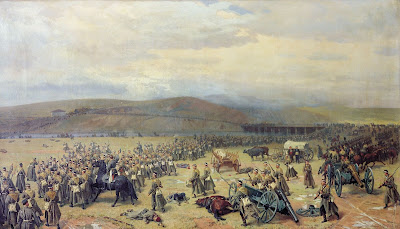Admiral Geoffrey Hornby
Besika Bay
Feb. 8, 1878
To the Right Hon. W. H. Smith, M.P.
The Russians are said to have 3000 men at Rodosto, sixty miles from
Bulair ; a force—amount unknown—at Kissen, thirty miles off; and the roads from
the north, through Malgara, and generally, are bad. I think, therefore, they
could not approach the place under three days, or have a large force there in
less than six days.
In twenty-four hours we could land at Gallipoli a naval brigade of 500
men, and flank the approaches to a certain extent in the ships. This would give
the Turks the encouragement and assurance they require, after their recent
defeats, to hold the ground for a few days. If orders were sent to the Governor
of Malta to co-operate with me, I should send Agincourt, Achilles, and Raleigh
to Malta, and they should return in eight days to Gallipoli with 3000 troops.
(Distance to Malta, 690 miles; return to Gallipoli, 730 miles.) Steamers should
be chartered at Malta, and despatched forty eight hours after receipt of the
telegram, bringing guns, ammunition, biscuit, rum, and cocoa for the troops,
and 2000 tons of coals for this squadron. With 3500 English, the ships, and the
Turks, I believe we should hold the place for a fortnight against anything the
Russians could do.
By that time—that is, twenty-two days from the receipt of your
telegram—you ought to be able to send us the 8000 or 10,000 men that would make
this place safe for ever. The first steps will be the most important, and of
course the orders must be prompt and decided from home. Troops, ships, and
Ambassador would then co-operate. Transport animals and temporary shelter for
the troops will be the greatest difficulty, but I believe we can meet them. You
may depend I will feed and shelter my own men, and I have great confidence in
our contractor, who is an Englishman. I mention this only that you may not
suppose such matters have not been considered.
Yours faithfully
G. Phipps Hornby





